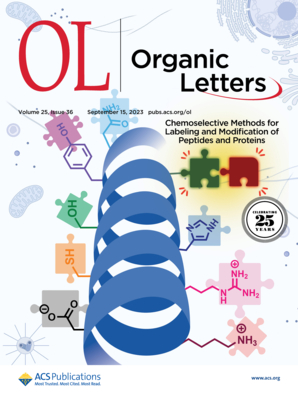Rh 催化吲哚衍生物的 C-H 烷炔化反应与银(I)控制的调节发散作用
IF 5
1区 化学
Q1 CHEMISTRY, ORGANIC
引用次数: 0
摘要
我们揭示了在铑催化的吲哚衍生物 C-H 烷炔化反应中,银(I)通过调整 C-H 金属化模式,在特戊酰基引导基的帮助下诱导了区域选择性的转换。通过明智地选择 AgOAc、Ag2O 和 Ag2CO3,可分别得到一系列 C2-炔化吲哚、C4-炔化吲哚和 C2,C4-二炔化吲哚。通过衍生成有价值的吲哚类化合物,证明了炔烃片段的合成用途。本文章由计算机程序翻译,如有差异,请以英文原文为准。

Rh-Catalyzed C–H Alkynylation of Indole Derivatives with Silver(I)-Controlled Regiodivergence
We have disclosed silver(I)-induced switching of regioselectivity in rhodium-catalyzed C–H alkynylation of indole derivatives with the help of a pivaloyl directing group by tuning C–H metalation modes. The judicious choice of AgOAc, Ag2O, and Ag2CO3 affords an array of C2-alkynylated indoles, C4-alkynylated indoles, and C2,C4-dialkynylated indoles, respectively. The synthetic utility of the alkyne fragment is demonstrated by derivatization into valuable indole-based compounds.
求助全文
通过发布文献求助,成功后即可免费获取论文全文。
去求助
来源期刊

Organic Letters
化学-有机化学
CiteScore
9.30
自引率
11.50%
发文量
1607
审稿时长
1.5 months
期刊介绍:
Organic Letters invites original reports of fundamental research in all branches of the theory and practice of organic, physical organic, organometallic,medicinal, and bioorganic chemistry. Organic Letters provides rapid disclosure of the key elements of significant studies that are of interest to a large portion of the organic community. In selecting manuscripts for publication, the Editors place emphasis on the originality, quality and wide interest of the work. Authors should provide enough background information to place the new disclosure in context and to justify the rapid publication format. Back-to-back Letters will be considered. Full details should be reserved for an Article, which should appear in due course.
 求助内容:
求助内容: 应助结果提醒方式:
应助结果提醒方式:


